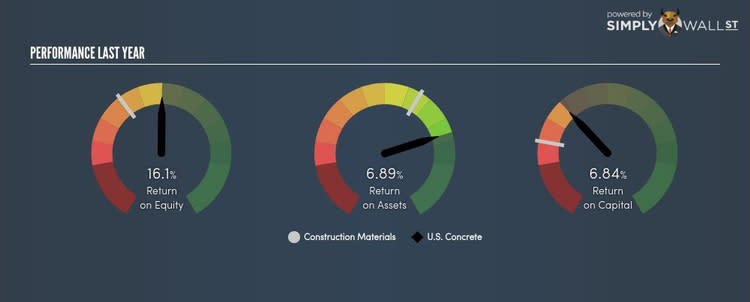Did US Concrete Inc (USCR) Create Value For Shareholders?

US Concrete Inc (NASDAQ:USCR) outperformed the Construction Materials industry on the basis of its ROE – producing a higher 16.10% relative to the peer average of 10.08% over the past 12 months. While the impressive ratio tells us that USCR has made significant profits from little equity capital, ROE doesn’t tell us if USCR has borrowed debt to make this happen. We’ll take a closer look today at factors like financial leverage to determine whether USCR’s ROE is actually sustainable. View our latest analysis for U.S. Concrete
Breaking down ROE — the mother of all ratios
Return on Equity (ROE) is a measure of USCR’s profit relative to its shareholders’ equity. It essentially shows how much USCR can generate in earnings given the amount of equity it has raised. While a higher ROE is preferred in most cases, there are several other factors we should consider before drawing any conclusions.
Return on Equity = Net Profit ÷ Shareholders Equity
ROE is assessed against cost of equity, which is measured using the Capital Asset Pricing Model (CAPM) – but let’s not dive into the details of that today. For now, let’s just look at the cost of equity number for USCR, which is 8.49%. Given a positive discrepancy of 7.61% between return and cost, this indicates that USCR pays less for its capital than what it generates in return, which is a sign of capital efficiency. ROE can be dissected into three distinct ratios: net profit margin, asset turnover, and financial leverage. This is called the Dupont Formula:
Dupont Formula
ROE = profit margin × asset turnover × financial leverage
ROE = (annual net profit ÷ sales) × (sales ÷ assets) × (assets ÷ shareholders’ equity)
ROE = annual net profit ÷ shareholders’ equity
The first component is profit margin, which measures how much of sales is retained after the company pays for all its expenses. Asset turnover reveals how much revenue can be generated from USCR’s asset base. And finally, financial leverage is simply how much of assets are funded by equity, which exhibits how sustainable USCR’s capital structure is. Since ROE can be artificially increased through excessive borrowing, we should check USCR’s historic debt-to-equity ratio. At over 2.5 times, USCR’s debt-to-equity ratio is very high and indicates the above-average ROE is generated by significant leverage levels.
What this means for you:
Are you a shareholder? USCR exhibits a strong ROE against its peers, as well as sufficient returns to cover its cost of equity. However, its high debt level appears to be the driver of a strong ROE and is something you should be mindful of before adding more of USCR to your portfolio.
Are you a potential investor? If USCR has been on your watch list for a while, making an investment decision based on ROE alone is unwise. I recommend you do additional fundamental analysis by looking through our most recent infographic report on U.S. Concrete to help you make a more informed investment decision. If you are not interested in USCR anymore, you can use our free platform to see our list of stocks with Return on Equity over 20%.
To help readers see pass the short term volatility of the financial market, we aim to bring you a long-term focused research analysis purely driven by fundamental data. Note that our analysis does not factor in the latest price sensitive company announcements.
The author is an independent contributor and at the time of publication had no position in the stocks mentioned.


